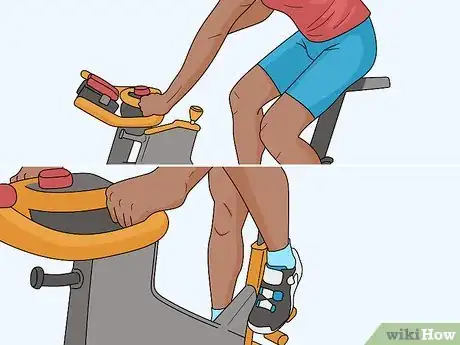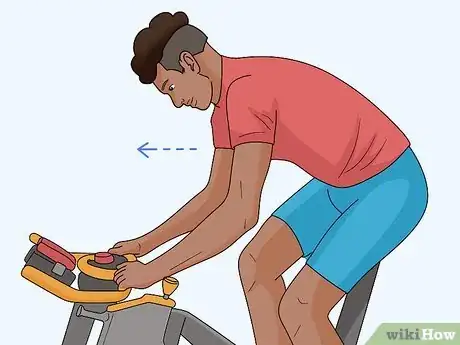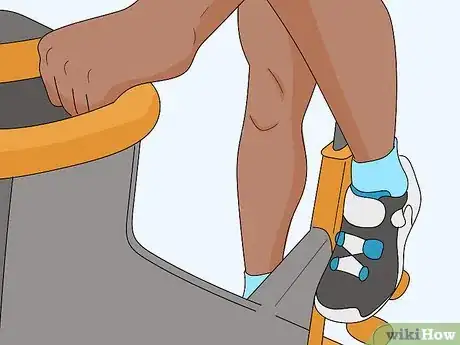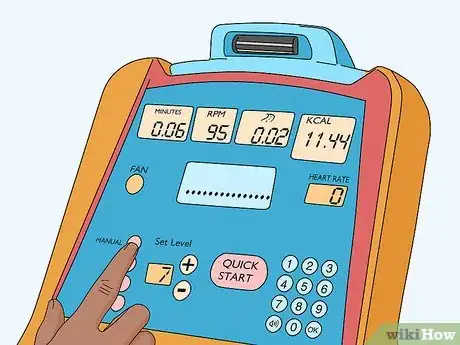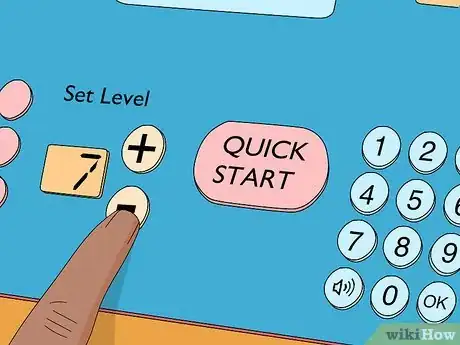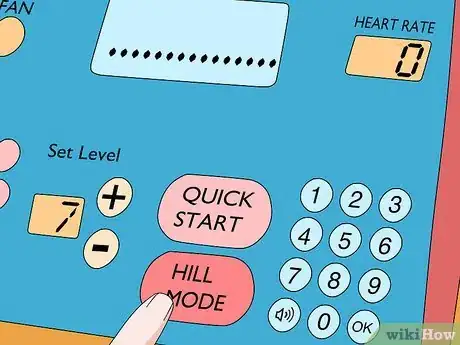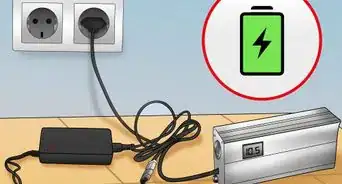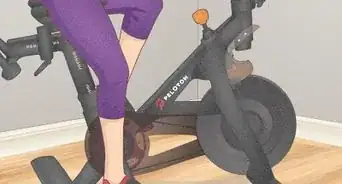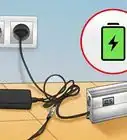This article was co-authored by Greg Maurer. Greg Maurer is a Health & Fitness Specialist and the Vice President of Fitness and Education for Workout Anytime. With over a decade of experience, he specializes in functional training, yoga, pilates, exercise and aging, home exercise programs, and numerous fitness diets. Greg holds a BS in Exercise Physiology from Temple University.
There are 12 references cited in this article, which can be found at the bottom of the page.
This article has been viewed 43,164 times.
Exercise bikes are everywhere. No matter what gym you visit, you’re sure to see rows of people pedaling in place. They are a great way to challenge your endurance and build stronger, sleeker leg muscles. One of the best features an exercise bike has is its adjustable resistance setting. If you know how to adjust it, the resistance lets you feel like you’re pedaling up inclines and coasting down hills. No matter how long you have been exercising, you can use resistance to customize a workout that makes you fitter and healthier.
Steps
Setting the Resistance Level
-
1Sit on the bike and place your feet on the foot pedals. Climb up onto the bike and face the handlebars. If you have an electric bike, its screen will be in front of you as well. Slide your feet under the pedal straps so your toes are at the end of the pedals. Make sure you are able to easily spin the pedals while also reaching the handles ahead of you.[1]
- Pull the pedal straps so they are snug but not restrictive against your feet. If your feet slide off while you're pedaling, stop and tighten the straps.
-
2Bend forward at the waist with your legs fully extended. Make sure your posture is correct before attempting to deal with the resistance setting. Always lean forward so you are able to keep a firm grasp on the handlebars and reach the control screen if your bike has one. Keep your back straight and your feet firmly on the pedals. If you’re on an upright bike, keep your knees directly above your feet so they don’t lock up while you’re pedaling.[2]
- Check the owner’s manual for more information about repositioning the seat. Most bikes have an adjustment lever underneath the seat, but some have controls near the handle. Use it to raise the seat or move it closer to the handles.
- Keep the bike’s seat roughly level with the tops of your thighs so you are able to pedal comfortably no matter what resistance setting you choose.
- The most important part is comfort. You can adjust your posture as long as you’re comfortable doing so. Some people like leaning forward more, but newer riders usually sit straight up and bend forward slightly.
Advertisement -
3Rotate the pedals to turn on the bike if it is electric. Watch for the screen to light up when you reach a certain speed. The screen will stay on as long as you keep pedaling at a low speed. You won’t be able to access the resistance controls when it’s off. Take some time to get your legs moving before tweaking the resistance setting.[3]
- If you’re on a mechanical bike, the resistance will be active as soon as you start pedaling. If the resistance is at a low setting, pedal for a while to get into a consistent rhythm before making a change.
- On some models, you will have to press a button to turn on the screen. Hit any of the buttons while pedaling to keep the display on.
- Double-check your posture. Make sure you feel comfortable using the bike. High-resistance settings can put a lot of strain on your muscles, so don’t make a change until you’re ready for it.
-
4Press the manual workout button if you’re on an electric bike. Take a peek at the buttons underneath the screen. Newer exercise bikes often have several different settings you can use to jump into an exercise routine. The buttons will all be labeled, so the manual button won’t be tough to find. By using the manual setting, you can adjust the resistance to your liking.[4]
- Some bikes have buttons for settings like “hill workout.” If you press one of those buttons, the bike runs a pre-programmed workout routine. It doesn’t give you as much of an opportunity to change the resistance level.
- If you’re on a mechanical bike, you won’t have any additional buttons to deal with. Just start pedaling to prepare for the change in resistance.
-
5Use the controls on the keypad to adjust resistance on an electric bike. Look for the labeled resistance controls located underneath the screen. They are often shaped like arrows and marked with a plus and minus sign. Increase the resistance by hitting the up arrow or the plus sign. Decrease the resistance by pressing the down arrow or minus sign.[5]
- The bike takes a few seconds to adjust to the new setting. If you don’t feel the new resistance level kick in right away, just keep pedaling.
- When changing the resistance, adjust it gradually. That way, you can get a taste of how each resistance level feels and find the right one for your workout.
-
6Turn the resistance control knob if you’re on a mechanical bike. The control knob is between the handlebars on the bike’s stem. Turn it clockwise to increase the resistance. Decrease the resistance level by turning the knob counterclockwise. Wait a few seconds while continuing to pedal. The bike will switch to the new setting.[6]
- Some exercise bikes have labeled resistance controls. The knob could have a plus and minus sign or numbers. Others don’t have any sort of label at all.
- Adjust the resistance a little at a time, especially if the control knob isn’t well-labeled. With a manual bike, you can easily set the resistance way too high or low by making big adjustments.
Using Different Resistance Settings
-
1Start at a resistance between 1 and 4 if you’re a beginner. Use a low setting, like 1, while you’re warming up your muscles and getting accustomed to riding an exercise bike. If you’re able to maintain your speed and posture, then bump up the resistance setting gradually. Resistance makes pedaling harder, so don’t overexert yourself by jumping up to a high level you aren't prepared for.[7]
- The resistance setting indicates how hard you have to push to move the bike forward. It is used to simulate what you would experience riding a bike outdoors, like when you’re riding up a hill.
- Low resistance settings, like 1 to 5, are great for aerobic exercise. They don’t require you to use as much leg strength, so you can keep the bike’s wheels turning without tiring out quite as quickly.
- The idea is to aim for a brisk cadence, but with movements under control. You shouldn't feel like you're flailing.[8]
-
2Set the revolutions per minute (RPM) to 60 to simulate hills. RPMs indicate how many times the bike’s wheels turn in a minute. Some electric bikes track this. An RPM rating of 60 to 80 is similar to riding up a hill, so it’s a good way for a new rider to strengthen their leg muscles.[9] At a low resistance setting, you may feel like you’re doing a lot of work because you’re going fast, but you won’t be strengthening and toning your legs very much.[10]
- To calculate the RPM on your own, hold your hand above your knee. Count how many times your knee touches your hand in a minute.
- An RMP rating of 80 to 100 is good for replicating flat ground. Lower the resistance setting or RPM rating when you need a break. Raise it up when you need more of a challenge.
- Remember to set the resistance to a comfortable level. If you’re having trouble at 60 RPMs, lower it so your legs get stronger. Experienced riders often go as high as 110 RPMs, but getting there takes practice.
-
3Decrease the resistance if you’re having a hard time pedaling steadily. At the right setting, you will be able to pedal at a steady rate without changing your posture. Note when you lean forward after turning up the resistance. If you start leaning to the sides, then turn the resistance down a little. Another sign is when your pedaling seems choppy and your legs no longer move forward in smooth, consistent circles.[11]
- If you’re using an exercise bike, you’re probably going to push yourself too hard. It happens a lot in classes that use bikes.
- There is no shame in lowering the resistance to a more comfortable setting. If you’re using a setting you aren’t prepared for, you won’t get a good workout and your legs won’t grow stronger.
- To see when the resistance is too low, look for the opposite signs. If you’re pedaling too freely and bouncing in the seat, bump the resistance up to the next level to help you regain control of your movements.[12]
-
4Switch between your highest and lowest resistance for high-intensity workouts. Generally, you won’t spend the entire time on a bike riding at the same speed. You can do something called high-intensity interval training (HIIT) by varying up the resistance. Start at a high setting you can handle, like a resistance level of 6. After a set amount of time, dial the resistance down to a comfortable, lower setting like 3 to rest and recover your strength.[13]
- For example, you can use the resistance to simulate riding over some hills. Turn the resistance up so it’s like you’re pedaling up a hill, then turn it back down for when you’re coasting down the hill or going over flat ground.
- Interval training is broken up into sections. For instance, you might ride at a high resistance setting for 5 minutes, go back to a lower setting for 5 minutes, then go back up to a higher setting.
-
5Try a guided workout on an electric bike to test out different resistances. For example, your bike might have a button labeled “hill mode.” When you press it, it creates a workout similar to what you would experience going up and down a bunch of hills outdoors. It’s a great way to get a good workout without having to reach for the resistance control every few minutes. It will have some high-resistance sections to build your leg strength and some low-resistance parts where you can take things slow.[14]
- The modes available will vary depending on the kind of bike you have. If your bike has an electric screen, there is a good chance it has a few modes, like hills, mountains, cardio, strength, or endurance training.
- If your bike doesn’t have these options, the best way to create a workout routine is by adjusting the resistance on occasion. Turn it up when you want to challenge your strength, then turn it back down when you need a break.
Warnings
- Using an exercise bike improperly can cause soreness and pain. To avoid this, maintain a proper posture and avoid using a higher resistance setting than you can handle.⧼thumbs_response⧽
References
- ↑ https://udayton.edu/studev/_resources/files/campusrec/fitness/equipment-orientation.pdf
- ↑ https://udayton.edu/studev/_resources/files/campusrec/fitness/equipment-orientation.pdf
- ↑ https://www.youtube.com/watch?v=XugMoMDxyhM&feature=youtu.be&t=71
- ↑ https://www.health.harvard.edu/heart-health/pedal-your-way-to-better-heart-health
- ↑ https://www.youtube.com/watch?v=XugMoMDxyhM&feature=youtu.be&t=86
- ↑ https://exercisebikesexpert.com/how-to-release-tension-on-spin-bike/
- ↑ https://www.ihs.gov/MedicalPrograms/Diabetes/HomeDocs/Tools/QuickGuides/PA_exercise_modes_508c.pdf
- ↑ Greg Maurer. Health & Fitness Specialist. Expert Interview. 13 August 2021.
- ↑ Greg Maurer. Health & Fitness Specialist. Expert Interview. 13 August 2021.
- ↑ https://www.24life.com/speed-vs-resistance-on-the-indoor-bike/
- ↑ https://www.health.harvard.edu/blog/spinning-heart-joints-2018022413237
- ↑ Greg Maurer. Health & Fitness Specialist. Expert Interview. 13 August 2021.
- ↑ https://www.ihs.gov/MedicalPrograms/Diabetes/HomeDocs/Tools/QuickGuides/PA_exercise_modes_508c.pdf
- ↑ https://www.youtube.com/watch?v=XugMoMDxyhM&feature=youtu.be&t=76
- ↑ https://www.ncbi.nlm.nih.gov/pmc/articles/PMC4827362/
- ↑ http://www.bu.edu/articles/2015/stretch-before-exercise-not-so-fast/
